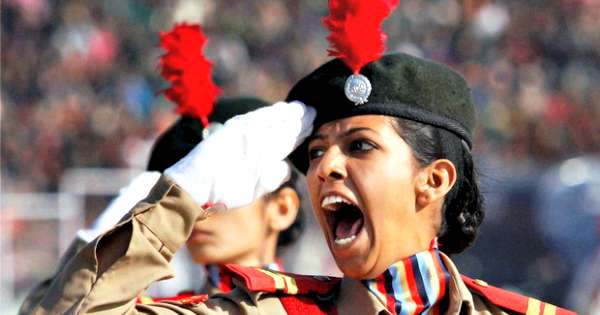The National Cadet Corps is the Indian military cadet corps with its Headquarters at New Delhi. It is open to school and college students on voluntary basis. National Cadet Corps is a Tri-Services Organization, comprising the Army, Navy and Air Force, engaged in grooming the youth of the country into disciplined and patriotic citizens. The Cadets are given basic military training in small arms and parades. The officers and cadets have no liability for active military service once they complete their course but are given preference over normal candidates during selections based on the achievements in the corps.
Although NCC can’t match the standards of IMA, OTA, NA, AFA and NDA, it is a better start for the candidates who realized their dreams of joining the Indian defence after their schooling. Also, NCC, given the vast benefits, opportunities and reservation, is the largest voluntary youth organisation in the world abiding by it’s motto; Unity and Discipline.
Here is a glimpse of what you want to know everything about NCC and clearing common misconceptions regarding it:
- The origin of NCC can be traced back to the ‘ University Corps’ , which was created under the Indian Defence Act 1917, with the object to make up the shortage of the defence services.
- National Cadet Corps is a Tri-Services Organisation , comprising Army, Navy and Air Force, engaged in grooming the youth of the country into disciplined and patriotic citizens.
- The motto of NCC is ‘Unity & Discipline’ which was adopted on 23 Dec 1957. In living up to its motto, the NCC strives to be and is one of the greatest cohesive forces of the nation, bringing together the youth hailing from different parts of the country and moulding them into united, secular and disciplined citizens of the nation.

- The current existing NCC tricolour flag was introduced in 1954. The three colours in the flag depict the three services in the Corps, red for Army, deep blue for Navy and light blue for the Air Force. The letters NCC and the NCC crest in gold in the middle of the flag encircled by a wreath of lotus, give the flag a colourful look and a distinct identity. Each lotus represents one NCC Directorate(Dte).
- The desirability of composing a NCC song was considered in January 1956. An Official Song of the NCC titled “Kadam Mila Ke Chal” was adopted in 1963 and registered in 1969 with the approval of Ministry Of Defence. In 1974 it was felt that the NCC song has failed to catch the imagination of the youth and there was need for a change. In Oct 1982, it changed to the current NCC Song titled “Ham Sabh Bhartiya Hain” . “Ham Sabh Bhartiya Hain” – NCC song is written by Haricharan Singh Parvana.
- 32 seats are reserved per course in the IMA for cadets who have passed NCC `C` certificate examination. NCC cadets having 50% aggregate marks in graduation with minimum `B` grade in `C` certificate examination are eligible for short service commission( NCC special entry scheme) without qualifying CDS written examination. They will face direct SSB interview. Seems a good deal for facing direct SSB, right?
- Various incentives are given to the cadets ranging from cash to kind. Also, the cadets gets a chance to attend various camps nationwide and also internationally.
- NCC provides academically brilliant students with scholarships for sponsoring their education. The NCC welfare society grants 500 scholarships of Rs 5,000/- each to NCC Cadets who excel in academics. The vacancies are allotted to all states based on the enroled strength of each state.
NCC is the organisation which gives the Indian youth a glimpse of what it feels like to be an officer in the Indian armed forces. The respect you get in the society, the pride in you wearing the uniform makes you totally different from your classmates not in NCC. With over 13 lakh active personnel, it is one of the largest reserve forces in the world with Lt Gen Anirudha Chakravarty heading the organisation as the Director General.
I hope this article might’ve made thoughts and mindsets clear about NCC and I hope it’ll open more opportunities for the aspirants to join the Indian defence forces. If you have anything to say on this, do comment below.





